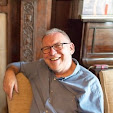Professor
Woody Caan is a professorial fellow of the Royal Society for Public Health and editor
of the Journal of Public Mental Health. Earlier this year, Professor
Caan kindly invited me to contribute an article to the journal which, I'm
delighted to say, is published in this month's issue (Gillam, 2018a). I ended up giving my article the rather wordy
title: Enhancing public mental health and wellbeing through creative arts
participation. In it, I discuss how,
as a mental health nurse with a lifelong interest in creativity and the
creative arts I have, for many years now, explored creative approaches to fostering
wellbeing. While my main professional focus has been on the wellbeing of the users
and providers of mental health services, this has been in the context of an
underlying assumption that the mental health and wellbeing of the wider
community can also be enhanced through creative activity.
One of the
areas of participatory arts on which the article focuses is my work in
community music with an initiative called the Music Workshop Project. As I
explain in the article: "in my most recent book, I wrote
elegiacally about the Music Workshop Project, believing my days of therapeutic music-making
were over. Serendipitously, however, I have more recently been invited by
Dudley MIND (a local West Midlands branch of the Mental Health charity) to facilitate a
series of music workshop sessions for wellbeing."
I go on to describe a shift in my attitude to this
kind of work: "Although
I remain a registered mental health nurse, I approach these sessions as
participatory arts activities which I facilitate as a musician rather
than as a nurse. In this context, I am a musical group leader or, as McNiff (2004) might more
poetically describe it, the 'keeper' or 'caretaker' of the 'studio' or creative
space. I have found it helpful, in being clear about my role, to identify with
McNiff's view that: "As a 'keeper'
or 'caretaker' of the studio, my primary function is to kindle the soul of the
place, to maintain its vitality and its ability to engage people in highly
individual ways..." (p.20). This is
not how mental health nurses would typically describe their function though I
would argue that, if nurses are to be truly concerned with the wellbeing of
society (and not just the health of mental health service users) then they do need
to be skilled at facilitating flourishing (Gillam, 2018b.)"
At the end
of November, I ran one of these sessions for Dudley MIND. All the participants
seemed to enjoy the mixture of improvised extended 'jams' and on-the-hoof, ad-libbed
renditions of half-remembered pop songs. We even did a few Christmas tunes, knowing
that we would not be meeting again until after the festive season. After the
session had ended, I asked a first-time participant how he found the group.
"Yes, it was alright that was," he said. "I've been to some of the other
activities - quizzes and things - but I can't always think what to say quick
enough. But with this music group, that doesn't
matter. I think I'll come again."
References
Gillam, T.
(2018a). Enhancing public mental health and wellbeing through creative arts
participation. Journal of Public Mental Health 17 (4), 148-156.
Gillam, T.
(2018b). Creativity, wellbeing and mental health practice. London: Palgrave
Macmillan.
McNiff, S. (2004). Art heals: How creativity cures the soul. Boston, Mass.: Shambala Publications.





No comments:
Post a Comment